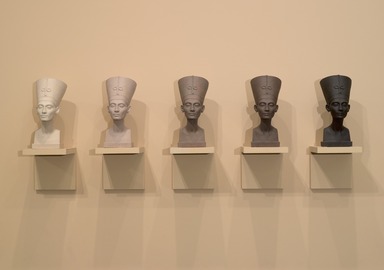
Part I: Ancient World Exhibit
This is a pair statue of Nebsen and Nebet-ta. In the statue, I see two individuals that are are linked together by their left and right arms, hence why it is called a “pair statue.” I don’t exactly know if the two individuals in the sculpture are, but I am assuming it can be a man and woman of high power sitting holding hands. It can also be a husband and wife, two siblings, mother and son, or father and daughter. My assumptions are based on the distinct gender difference between the two individuals. The one on the right has pronounced breasts and larger eyes and the left person has a more structured jaw. Also, the person on the right has a black outlining around her eyes and is more indication the right individual is a female. Some other things I have seen is that the man has a different headset than the person on his right. Actually, the women has no headset and only has visible hair and only a necklace. Looking at the larger picture, both individuals are sat on top of a throne or maybe just a regular chair. The linking of arms indicate the two individuals are very close to each other, both physically and spiritually. The physical dimensions of the sculpture according to the catalogue description is: 15 7/8 x 8 9/16 x 9 1/4 in. (40.4 x 21.8 x 23.5 cm). The medium seems to be limestone. There are engravings on the “skirts” of each individual. On the sides and back of the throne/chair, there are more hieroglyphs.
Part II Museum Assignment: Soul of a Nation Exhibit
One Soul of a Nation art piece has particularly grabbed my attention and it is Wadsworth Jarrell’s Black Prince. What caught my eye is the myriad of colors used, but the colors that caught my attention first were red, blue, and yellow. A bulk of the artwork is red and white. Half of Malcolm’s face is mostly red and the other half is white with a few other colors such as yellow, red, and green. The overall theme of Soul of a Nation is Black excellence. The words painted on this piece are: “To correct unjust conditions,” “I Believe in Anything and Everything,” “As long as it get results,” and “Political, Economical, Social, Physical, Anything Necessary.” This painting is similar to the other paintings in the Soul of a Nation exhibit in that the paintings sheds light on Black power and Black artists in the 1960s to 1980s. It brings a large population of black artists to collaborate and share their ideas. As for the formal properties, the painting is acrylic on canvas, measures 44 cm by 64 cm. The artist painted this in 1971 which is, as mentioned before, a prominent and flourishing time for black power and black excellence. This was also a time of the Civils Rights movements which is why Malcolm X is present in this painting. The emergence of black leaders and movements during this time period inspired these paintings.



